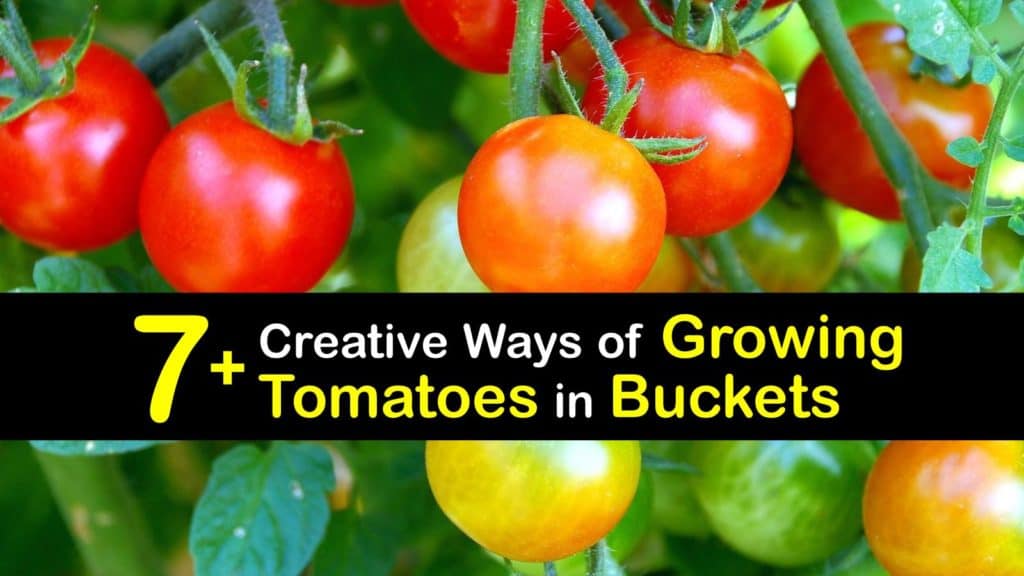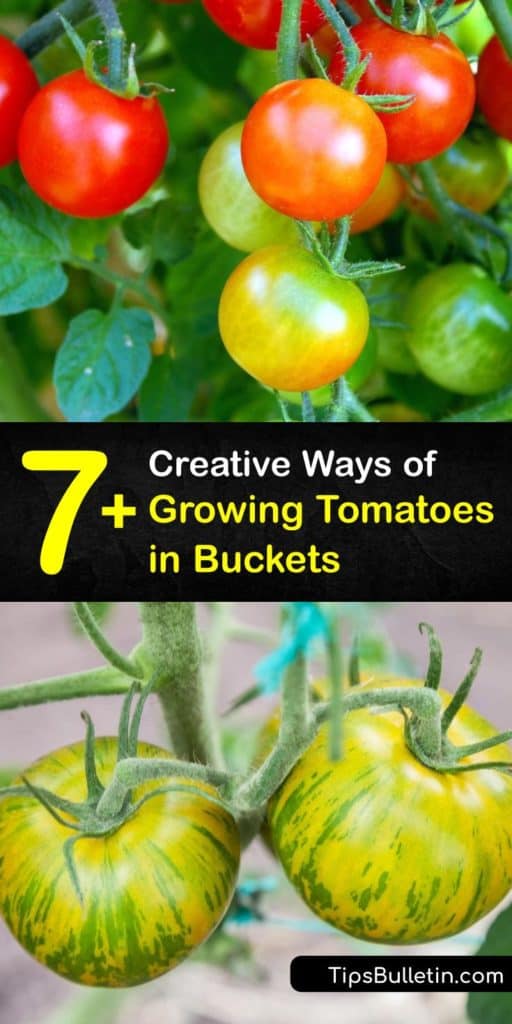If you’ve been missing out on growing tomatoes because you think you don’t have enough space in your garden or raised bed, think again. Growing tomatoes in buckets is an excellent way to enjoy fresh homegrown tomatoes picked right from your porch, patio, or even indoors.
The key to success when planting tomatoes is to ensure that you give their roots enough space. For this reason, a five gallon bucket works perfectly for container gardening. Using a black bucket and placing the tomato plant in a sunny location near a wall helps keep the soil and root system warmer in colder climates.
In this article, you’ll learn how to grow tomatoes in a bucket, what kind of soil and fertilizer to use, how to harvest fresh tomatoes, and what to do about pest and disease problems. Use these simple tips and tricks to enjoy a regular harvest of your own tomato crop.

- How to Grow Tomatoes in a Bucket
- Ideal Conditions for Growing Tomatoes in Buckets
- Growing Tomatoes from Seed
- How to Plant Tomatoes in a Bucket
- Turning 5 Gallon Buckets into Tomato Planters
- Optimal Potting Soil for Growing Tomatoes in Buckets
- How to Choose the Right Fertilizer
- Common Problems with Container Tomatoes
- Companion Plants for Tomatoes in a Container Garden
How to Grow Tomatoes in a Bucket
One of the advantages of planting tomatoes in buckets is the fact that they’re portable. It’s easy to move your tomato planters around your container gardening space to take advantage of the best growing conditions. It also solves the problem of learning how far apart tomato plants need to be since you can shift positions easily.
Crucial factors to keep in mind include light, heat, moisture, and protection from the elements. When choosing which tomato varieties to grow, it’s essential to understand the difference between determinate and indeterminate tomatoes.
The leading differences between the two are their mature size and harvest times. Determinate tomatoes have a bushy growth pattern and eventually reach a maximum size at which they stop growing.
Determinate tomatoes tend to have all of their fruit ripen at once and generally have a compact growth habit.
Indeterminate tomatoes continue growing and producing fruit as long as conditions allow. Most cherry tomatoes are indeterminate.
However, some stay more compact than others. Regular pruning helps maintain airflow, control the plant’s size, and promote healthy new growth.
Ideal Conditions for Growing Tomatoes in Buckets
There are many different fruits and veggies that make up the easy to grow edible plants in buckets. Planting tomatoes in a bucket is relatively easy. All you need is a drill to create drainage holes, a saucer to catch draining water, rich potting soil, and a location in full sun. It’s helpful to use a trellis or tomato cage to support heavy vines and branches.
If you have a short growing season, plant tomatoes from seed in early spring or buy larger plants from your local garden center after the last danger of frost has passed. Placing potted tomatoes near a wall helps keep them warmer due to the radiant heat.
Tomatoes require consistently wet soil to produce fruit. If the root system dries out too much, leaves might wilt or get crispy, and fruit may split and scar.

Use a potting mix rich in organic matter and that holds moisture well. Applying a layer of mulch or peat moss on top of the soil helps retain moisture and keep the soil warm.
You can also grow mushrooms in a large pot or bucket but they have different requirements from tomatoes.
Growing Tomatoes from Seed
Start your tomato seeds in early spring, about six to eight weeks before the last danger of frost in your area.
Use a seedling tray with two-inch cells, peat pots, or egg cartons to plant tomato seeds. Your seed starting potting mix should be well-draining and rich in nutrients.
Plant tomato seeds a quarter-inch deep and cover lightly with soil. Use a spray bottle or mister to lightly saturate the soil. Cover the seedling tray with a humidity dome or sheet of plastic wrap to keep the soil consistently moist.
The ideal soil temperature for germination is 70-75℉. The top of your refrigerator is often a perfect location to germinate seeds. Otherwise, use a heat mat to keep the soil warm.
Most tomato varieties germinate within five to ten days. Once they sprout, ensure the seedlings receive at least six hours of bright light daily. If keeping seedlings on a south-facing windowsill, regularly rotate the tray so the seedlings lean away from the light.
This movement helps them develop strong stems. If you don’t have a sunny window available, consider using a grow light to prevent seedlings from becoming elongated or “leggy.”
How to Plant Tomatoes in a Bucket
Whether growing your own tomato seedlings or purchasing starts from a plant nursery, transplant your baby tomatoes into progressively larger pots when the roots emerge from the drain holes.
Avoid increasing the pot size by more than two inches at a time. If there’s too much extra soil that the root system isn’t touching, fungus and bacterial disease could develop.
When transplanting tomato seedlings, bury about one-third of the plant. Tomato plants develop roots from the light-colored nodes along their central stems. Remove the bottom third of the leaves, and place the root ball in the pot’s bottom.
Use one hand to support the plant while you fill in with soil. Lightly press the top to compact it somewhat and support the weight of the plant. When it’s time to transplant your tomato into its final home, insert the tomato cage while the plant is still small.
Doing so helps avoid breaking branches and damaging the root system by installing the tomato cage when the plant is mature. Alternatively, use a trellis at the back of the pot and tie the branches to the trellis as the tomato plant grows.
Turning 5 Gallon Buckets into Tomato Planters
A five gallon container makes the perfect DIY tomato planter. Drill six half-inch drainage holes evenly spaced over the bucket’s base. To prevent water from leaking out, place a saucer underneath the bucket.
Fill it about halfway with potting soil. Remove the seedling from its previous pot and clip off the lower leaves.
Place the root ball in the center of the bucket along with two tablespoons of organic fertilizer. Fill in with soil and compost until the tomato plant is sufficiently buried.
Alternately, try hanging the buckets on sturdy hooks to make hanging baskets. Drill six small holes evenly spaced over the bucket’s bottom and cut a three-inch-wide hole in the center.
Carefully insert the root ball and part of the tomato plant’s stem into the hole in the bottom of the bucket, then fill with soil. Roma and cherry tomatoes are the best varieties for growing upside down in hanging baskets.
Optimal Potting Soil for Growing Tomatoes in Buckets
It’s vital to select a potting mix with added peat moss or coconut coir for moisture retention. However, you also don’t want the soil to stay soggy.
Try making a DIY potting soil blend using the following recipe. It’s more cost-effective than purchasing a specialty potting mix at a garden center. And, you have the peace of mind that comes with knowing exactly what’s in the soil you’re using to grow food.
Use a hand rake or trowel to blend the ingredients in a large wheelbarrow. It’s best to use all of your homemade potting soil at once. If that’s not possible, store the mixture in a cool, dry location in a sealed plastic bag.
How to Choose the Right Fertilizer
There are three fundamental nutrients present in plant fertilizer: nitrogen (N), phosphorus (P), and potassium (K).
Nitrogen promotes green leafy growth, phosphorus encourages robust root systems, and potassium stimulates fruiting and flowering processes.
When tomato plants are still young, use a balanced, organic fertilizer. For the first few weeks after transplanting, pinch off the flowers to direct the plant’s energy toward growing larger.
Once it reaches about two-thirds of its mature size, stop removing flowers and switch to a fruiting and flowering specific fertilizer with higher phosphorus levels and potassium than nitrogen.
Apply granular organic fertilizer every other week through the growing season. Another option is to create a DIY fertilizer blend. Try using the following recipe to feed your fruiting tomato plants.
Mix the ingredients in a large bucket with a lid, then let it cure for at least two or three weeks. Apply a quarter-cup of fertilizer when planting tomatoes in a bucket and provide supplemental feeding once per month throughout the growing season.
If your plants start exhibiting signs of distress or diminished fruit set, try making fertilizer tea and spraying it on the tomato plant’s leaves for foliar feeding. To make fertilizer tea, combine one pound of your DIY fertilizer with two gallons of water in a sealed bucket.
Allow the “tea” to steep for one week, then strain the liquid and spray it on your plants’ leaves. Add the sediment to your compost pile, or spread it on top of the garden soil around the plant’s base.
Common Problems with Container Tomatoes
Some of the most common problems that tomato growers encounter don’t come from insects or fungal disease but nutrient deficiency. Ensuring that your plants get all the nutrients they need fortifies them against pests and disease.
Blossom end rot, signaled by a water-soaked brown spot on the fruit’s end, is caused by calcium deficiency. Remove any fruit exhibiting signs of blossom end rot immediately.
Epsom salts, rock phosphate, and earthworm castings are excellent remedies. Apply following the instructions on the package.
Yellowing leaves are frequently a sign of overwatering but sometimes indicate a magnesium deficiency. Magnesium facilitates chlorophyll production.
A lack of magnesium causes a mottled yellow pattern streaked with green veins to emerge, first on the lower leaves and progressively spreading higher.
Leaves may appear purple or brown if the problem persists. Epsom salts are the best remedy for magnesium deficiency. Mix one tablespoon of Epsom salts with one gallon of water and spray the leaves.
Companion Plants for Tomatoes in a Container Garden
Companion planting is a useful garden design technique that groups compatible plants to utilize their beneficial qualities. Some plants attract beneficial insects, repel pests, and enhance their neighbors’ flavor and overall growth.
However, some plants are not compatible and should live separately. Companion planting is an excellent strategy for container gardening to maximize your use of space and keep your plants thriving.
When considering how to plant tomatoes in a bucket, here are a few companion plants to consider.
Marigolds repel various pests, including ants, aphids, tomato hornworms, whiteflies, thrips, and harmful soil nematodes. They also attract pollinators and beneficial predatory insects like ladybugs, hoverflies, and parasitic wasps.
Basil also works well to repel insect pests like aphids, tomato hornworms, whiteflies, mosquitos, and house flies. Many gardeners claim that basil also enhances the flavor of tomatoes when grown together.
Leafy greens like lettuce and spinach have shallow roots that don’t compete with the tomatoes, and they act as living mulch to hold moisture and keep the soil cool in the heat of summer.
Planting tomatoes in buckets is an excellent low-cost container gardening technique. Grow fresh heirloom tomatoes right on your deck or patio, or plant tomatoes upside down and use a five gallon bucket as a DIY hanging basket.
When considering how to plant tomatoes in a bucket, use nutrient-rich soil enhanced with organic fertilizer. Plant the seedling deep so that it develops a robust root system.

If you found these tips and tricks about how to grow tomatoes in a bucket helpful, please share this article about growing tomatoes in buckets with your fellow green thumbs on Pinterest and Facebook.